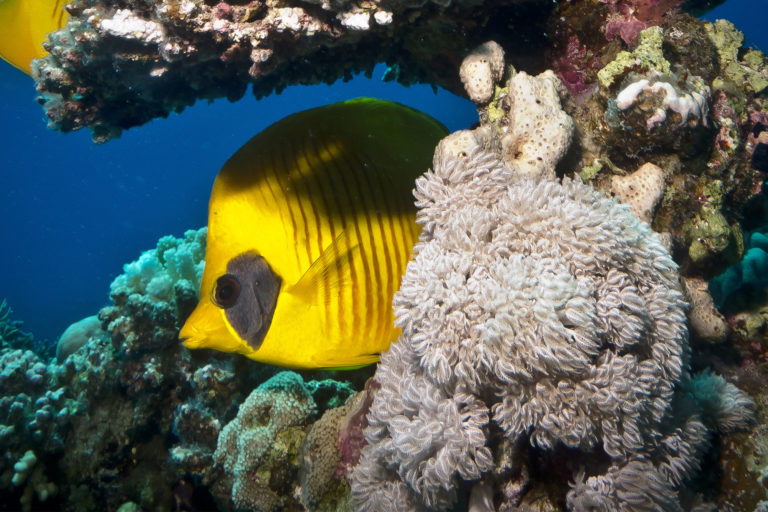- An international team of researchers studied the behavioral changes among butterflyfish on a series of reefs in the Indo-Pacific before and after the 2016 global mass coral bleaching event.
- They found that following the bleaching event, fish behaved more aggressively toward one another in their newly degraded reef home.
- The energetic toll of encounters involving fighting and chasing one another could have implications for the long-term survival of reef fish species, the study authors conclude.
- Given rates of ocean warming and predictions for more frequent and intense coral bleaching over the longer term, it’s unclear whether reef fish have the capacity to adapt their behavior to their rapidly changing environments.
As mass coral bleaching events grow in frequency and intensity, scientists are finding out more about how corals, which make up the physical foundation of reefs, respond during times of heat stress. But what is less well known is how mass bleaching events affect other components of reef ecosystems, such as their amazingly colorful array of reef fish species.
When a team of scientists studying reef fish behavior in the shallow waters of the Indo-Pacific during 2016 were shocked by the onset of one of the worst-ever global bleaching events — a phenomenon caused by elevated sea temperatures — they quickly decided to view the tragedy as an opportunity to learn more about their subjects.
Their study, published recently in Proceedings of the Royal Society B, suggests that coral die-off due to mass bleaching events is disrupting conflict avoidance behaviors in reef fish. Fish living on newly degraded reefs are finding it harder to make the appropriate behavioral responses to competitors, say the researchers. As a result, they get into more fights and chases, expending their valuable, limited energy reserves and risking their long-term survival.
“By recognising a competitor, individual fish can make decisions about whether to escalate, or retreat from, a contest — conserving valuable energy and avoiding injuries,” Sally Keith, a senior marine biologist at Lancaster University in the U.K. and lead author of the study, said in a statement. “These rules of engagement evolved for a particular playing field, but that field is changing.”
Keith and her colleagues studied butterflyfish — a colorful group of coral-eating reef fish — at 17 sites across five Indo-Pacific regions, including Indonesia, Japan, the Philippines and Christmas Island. In total, they collected more than 3,700 observations of 38 species of butterflyfish before and after the 2016 bleaching event and compared their behaviors.
Coral cover declined 18-65% following bleaching across the study sites, with a group of corals called Acropora particularly decimated. Butterflyfish are particular connoisseurs of Acropora, often setting up territories around coral colonies belonging to the group. The loss of so much Acropora in 2016 dealt the butterflyfish a heavy blow but also enabled the researchers to study their response in detail.
Deprived of their favored fodder within their own territories, the butterflyfish typically roamed farther afield to seek alternative food sources, according to the study. In so doing, they encountered more competitors — usually different species of butterflyfish.
Crucially, the researchers observed that in the post-bleaching reef environment, fish failed more often to employ behavioral mechanisms that normally resolve conflicts. Under healthy reef conditions, for instance, territory-holding butterflyfish typically adopt a “signaling” posture whereby they point their nose down and raise their spiny dorsal fins to ward away intruders.

Prior to the 2016 bleaching event, fish used this signaling response to resolve between-species conflicts roughly 28% of the time. But after the bleaching, this dropped to only 10% of the time, with energetically costly attacks and laborious chases ensuing instead. The researchers suggest the increased aggression could be due to the loss of cues in the reef environment post-bleaching, meaning fish have trouble recognizing competitors and are prone to poor decision-making.
Michael Childress, an evolutionary behavioral ecologist at Clemson University in the U.S. who was not involved in the research, said the study findings are well supported by a substantial dataset. But he cautions against directly linking the changes in fish aggression to a failure to recognize competitors after the mass coral die-off.
A more likely and simple explanation, he said, could be that the coral die-off forced fish out of their newly impoverished territories to seek food elsewhere, bringing them into contact with novel species and heightening the chances of an aggressive encounter. “What really changes after the mass coral mortality is the value of holding a territory that is no longer stocked with valuable Acropora corals,” Childress said. “It is a resource value change, not a competitor perception change that has occurred.”

Notwithstanding the underlying cause, the researchers say the energetic toll of increased conflict might have implications for the long-term survival of reef fish species. It could also alter long-established relationships that have evolved over millions of years and enable so many different species to coexist in the same reef habitat.
Childress said it’s unlikely that the observed changes in butterflyfish behavior will directly impact coral reef fisheries in the region. The study didn’t record a notable decline in the number of butterflyfishes, he said. “As a result, there are just as many butterflyfish to feed the larger reef predators that people depend upon … the diet of large predators may contain hundreds of reef fish species, [so] it would be hard to imagine a consequence that links these behavioral shifts to measurable impacts on coral reef fisheries.”
With global warming increasing the likelihood of further bleaching events and coral losses, the researchers say the next step will be to find out whether butterflyfish and other reef species can adapt to their newly impoverished environments.
“These relatively small miscalculations in where to best invest energy could ultimately push [reef fish species] over the edge,” Keith said. “It’s not yet clear whether these fish have the capacity to update their rule book fast enough to recalibrate their decisions.”
Banner image: A butterflyfish in a coral reef in Egypt. Image by Christoph via Flickr (CC BY-NC-SA 2.0).
Citation:
Keith, S. A., Hobbs, J., Boström-Einarsson, L., Hartley, I. R., & Sanders, N. J. (2023). Rapid resource depletion on coral reefs disrupts competitor recognition processes among butterflyfish species. Proceedings of the Royal Society B: Biological Sciences, 290(1990). doi:10.1098/rspb.2022.2158
Carolyn Cowan is a staff writer for Mongabay. Follow her on Twitter @CarolynCowan11
FEEDBACK: Use this form to send a message to the author of this post. If you want to post a public comment, you can do that at the bottom of the page.
This story first appeared on Mongabay
South Africa Today – Environment
This article is licensed under a Creative Commons Attribution-NoDerivatives 4.0 International License.
You may republish this article, so long as you credit the authors and Mongabay, and do not change the text. Please include a link back to the original article.












